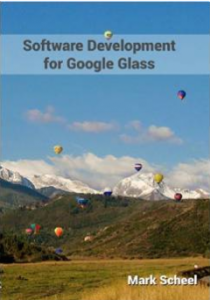A few months ago I had the privilege of working as a technical copy editor for a colleague of mine, Mark Scheel. His book Software Development for Google Glass is now officially released, so I can finally share my thoughts on the process and the book!
Mark is a wealth of information on all things Android, and definitely an expert in Google Glass. I was really excited when I heard he was working on a book about software development for Google Glass, and thrilled when I got the opportunity to work as a technical copy editor for the book.
Just like a traditional copy editor, I worked as a second set of eyes to catch any spelling, grammar, or formatting issues in the manuscript. As a technical copy editor, I put my Android and Glass development knowledge to use, and analyzed the manuscript’s technical explanations as well as the source code examples. As I walked through the manuscript I continuously asked myself these two questions:
- Would this explanation make sense to me if I had never done Glass development before?
- Does the code load, build and run on my development machine and Glass device the way it is explained in the manuscript?
As somebody who has read many coding books, I can tell you I really want the answer to both of these questions to be YES! And, I have felt the pain of reading a book where the answer to either (or both!) is NO. Bleh. I do understand that always answering YES to the second question is a bit tricky for coding books. Developers know that the industry is extraordinarily fast-paced, and we should be willing to give authors some leeway if the technology receives an update after the book has been printed. However, the answer to the second question should still be YES at the moment that the manuscript is sent to the press.
The book begins with an overview of Glass and a timeline of the product’s history. The reader then gets an overview of design principles for Glass before diving into environment setup and finally code projects. The whole book was awesome, but my most favorite parts were the timeline and the coding projects.
I joined the Glass Explorer program at firmware revision XE12, so I missed all the trials and tribulations that the earliest explorers experienced from XE4 to XE11. The timeline walks the reader through each firmware revision with notes about when certain features were released, tidbits on features that got completely axed, and insights on the Glass Explorer community reaction to it all.
The coding section was also great. It touched on different approaches to Glass development, and had several fun sample projects. With Glass development still in beta, there aren’t a whole lot of comprehensive tutorials or samples out there (relative to the Android phone platform). I always enjoy tweaking sample projects in coding books to learn more about how things work.
If you are interested in learning more about Google Glass development, you should check his book out on Amazon here. It is available both as a hard copy and on Kindle. Also, if you are going to be in the Boulder, CO area this week, Mark is speaking about Google Glass at the Boulder Android meetup!
Using my technical knowledge in this new way was a really neat experience, and I’d definitely be interested in doing this type of project again in the future. If you know of anyone looking for a technical copy editor, send them my way! 🙂

